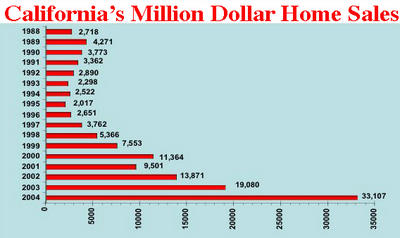More Million-Dollar Sales

This chart speaks volumes.
I was reminded that I had this data when I read an Associated Press story in Newsday by writer David B. Caruso. The story is about the increase in the number of million-dollar homes in New York and around the nation. Here's an excerpt from the story:
For the first time, there are more than 1 million owner-occupied homes in the United States worth $1 million or more, according to a Census Bureau survey published late last month.It's nice to see Caruso get at the issue of what this means for working class families. Not enough attention has been paid to that matter yet. I expect we'll be reading more in the future.
Once a symbol of unusual wealth, million-dollar dwellings now seem like a dime a dozen in some places. San Francisco alone has more than 20,000 of them. There are another 46,000, or so, in Orange County, Calif.
But the king of outrageous housing prices continues to be Manhattan, where even someone with a million dollars in their pocket can't buy luxury.
The average price for an apartment in all but Harlem and the borough's northern tip climbed above $1.2 million in the second quarter of 2005, said Gregory Heym, chief economist for Terra Holdings, an owner of real estate brokerages in the city.
"For a million dollars, you couldn't get a two-bedroom on the East Side," Heym said.
Real estate has become so hot that the boom has spread to neighborhoods formerly written off by many investors as hopelessly impoverished.
In Bedford Stuyvesant, the section of Brooklyn that was the setting for Spike Lee's 1989 film, "Do the Right Thing," some owners were asking more than $950,000 this week for their brownstones.
The prospect that a neighborhood that experienced rioting in the 1960s and a crack epidemic in the late 1980s would fetch such high prices now is both an urban success story, and potentially dismaying, said Richard Weeks, an agent at Coldwell Banker Mid Plaza Real Estate.
If a working-class family can't afford a home in Bed Stuyvesant, he asked, just where can they buy?
"As an African American, I worry about it," said Weeks, whose listings include a limestone town house in a fast-gentrifying section of the neighborhood, priced at $975,000. "It is definitely going to become harder for the people who aren't well off to purchase there."
Read all of Caruso's story at this link.
— The Boy in the Big Housing Bubble




<< Home